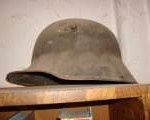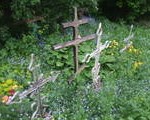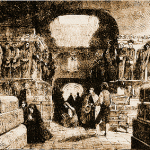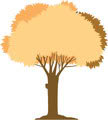Articles
Are You up to Date? By Paula Stuart-Warren, CG
February 20, 2008 by Chris
Filed under Introduction to Genealogy, Organizing Your Genealogy Research, Public Records
 I came across a heartfelt genealogy post at another blog and felt it was very much worth sharing. In her article, “Are You Up to Date,” Paula Stuart-Warren writes about keeping your family tree current with events in your family. While we may spend the majority of our time looking for distant ancestors, we need to remember to enter recent family data as well. She also discusses such topics as:
I came across a heartfelt genealogy post at another blog and felt it was very much worth sharing. In her article, “Are You Up to Date,” Paula Stuart-Warren writes about keeping your family tree current with events in your family. While we may spend the majority of our time looking for distant ancestors, we need to remember to enter recent family data as well. She also discusses such topics as:
- Obituaries and Tombstones
- Family Group Sheets
- Funeral Guest Books
- Social Security Death Index
- Other key considerations
Paula, if you read this, my condolences and thank you for sharing such a great article. It is truly the testament you intended and a solid introduction to Genealogy and thus I felt it fitting to share it with the visitors here.
You can read Paula’s full article here.
Thank you – Chris
Social Security Death Records
February 18, 2008 by Chris
Filed under Genealogy Death records, Genealogy Records 101, Public Records
 Another great article by Leo Talbot:
Another great article by Leo Talbot:
The Social Security Death Index (SSDI) contains the names and vital information of around 65 million deceased Americans. It is an extremely large and important database for genealogy enthusiasts. Information is archived in the SSDI when a death has been reported to the Social Security Administration (SSA), such as when a family member stops the Social Security Benefits (SSB) of a person, or applies for survivor’s benefits.
In the early 1960’s, the SSA began using computer technology to store vital records. Therefore, most records included in the SSDI have death dates of 1962 or later, and birth dates from the early 1900’s. Although there are a few birth dates as far back as the 1850’s, and death dates prior to 1960, not all earlier data has been entered into the current SSDI.
Social Security Death Records
Social Security Death Records (SSDR) usually contain the following data on a deceased individual:
- Last name
- First name
- Date of Birth
- Date of Death
- Where the last SSB was sent
- State of residence
- Where the SSN was issued
- Last known address
SSDI Search Tip #1: Use maiden names when searching for women. SSDI is a valuable genealogy tool. The SSDI can assist your genealogy research by providing data that will help you locate birth certificates and death certificates. By providing the names of parents, a female’s maiden name, people’s places of residence and their occupation, it may also assist in the search for marriage certificates and other vital records.
SSDI Search Tip #2 : Start your search on the SSDI with just a few facts. You can search on any combination of data. A last name and known possible birth period may be a good place to start. If the results are too large, add additional data and search again. Also, do not use middle initials – middle names are not recorded in the SSDI.
Soundex Search is a very useful feature that can assist where names may have been misspelled.
Leo Talbot writes genealogy articles such as the social security death index and others
(A Genealogy Beginner Sponsor)
Updated Confucius family tree has two million members
February 17, 2008 by Chris
Filed under Articles, Blank Family Tree, Latest News
 I thought this was interesting when I came across it. More than 2 million family members… that was a big genealogy project for sure! The Confucius Genealogy Compilation Committee tells us that the task of registering new members was completed in 2007 and the descendant report for Confucius is due to be published in 2009; 2,500 years after his death. Kong Dewei, a Confucius descendant who has been updating and directing the work on this project reports that there are over 1.3 million new “living member” entries to the Confucius family but deceased members have also been included.
I thought this was interesting when I came across it. More than 2 million family members… that was a big genealogy project for sure! The Confucius Genealogy Compilation Committee tells us that the task of registering new members was completed in 2007 and the descendant report for Confucius is due to be published in 2009; 2,500 years after his death. Kong Dewei, a Confucius descendant who has been updating and directing the work on this project reports that there are over 1.3 million new “living member” entries to the Confucius family but deceased members have also been included.
The work for this project began in 1998 when a 77th generation member Kong Deyong established the committee. To help complete the project over 450 branches of the committee worldwide were set up to assist with the work
Follow this link to Read the full story
…
Where to Next?
…
National Archives Celebrates Black History Month in February
February 15, 2008 by Chris
Filed under Articles, Latest News, Public Records
 The National Archives will be celebrating Black History Month in February with special films, lectures and public programs. These events will be at the National Archives Building in Washington, DC, and are open to the public. Some programs will also be held at the National Archives in College Park, Maryland. Unless otherwise noted all events are free.
The National Archives will be celebrating Black History Month in February with special films, lectures and public programs. These events will be at the National Archives Building in Washington, DC, and are open to the public. Some programs will also be held at the National Archives in College Park, Maryland. Unless otherwise noted all events are free.
- Panel Discussion and Banneker Monument Unveiling, February 15, at 7 P.M
- What’s New in the ARC (Archival Research Catalog)? February 20, at 11:30 A.M.
- Using Federal Records for African American Genealogical Research, February 23, 10:15 A.M.-1:30 P.M.
On Tuesdays and Fridays throughout February, the National Archives will be showing the landmark 14-part PBS series Eyes on the Prize. For the complete film schedule, as well as more information on other events taking place, please visit: http://www.archives.gov/press/press-releases/2008/nr08-42.html.
…
Where to Next?
Blank Family Tree with Step-by-Step Instructions
…
National Archives Marks World War I Veteran’s 107th Birthday
February 15, 2008 by Chris
Filed under Articles, Latest News, Public Records
 Archivists present last living American WWI veteran with a copy of his military file. WASHINGTON, DC* The National Archives celebrated the 107th birthday of the nation’s last living World War I veteran, Mr. Frank Woodruff Buckles, this week. To honor Mr. Buckles — and by extension all of the men and women who served — National Archives archivists Mitch Yockelson and Richard Boylan visited with Mr. Buckles at his home in West Virginia and presented him with a copy of his military service record.
Archivists present last living American WWI veteran with a copy of his military file. WASHINGTON, DC* The National Archives celebrated the 107th birthday of the nation’s last living World War I veteran, Mr. Frank Woodruff Buckles, this week. To honor Mr. Buckles — and by extension all of the men and women who served — National Archives archivists Mitch Yockelson and Richard Boylan visited with Mr. Buckles at his home in West Virginia and presented him with a copy of his military service record.
Frank Woodruff Buckles was born in Harrison County, Missouri, on February 1, 1901. He enlisted in the US Army in 1917, at the age of 16 (he said he was 18). During the war, he was stationed in the United States, United Kingdom, Germany, and France. He served as an ambulance driver, and after the Armistice was signed in 1918, he escorted prisoners of war back to Germany. Following the war, he was stationed in Germany, and he was discharged from service in 1920 having achieved the rank of corporal.
In the Second World War, Mr. Buckles was a civilian working for the White Star steamship line and was in Manila on business in December 1941 when the Japanese attacked Pearl Harbor. He was captured by the Japanese and spent over three years as a POW at the city’s University of Santo Tomas.
The archivists located records relating to much of Mr. Buckles’ service in Europe. The National Archives photo lab then scanned and made prints of nearly three dozen documents that comprise his military file. His file includes his troop ship manifest, personnel rosters, and a history of Base Hospital 35 in Winchester, England, where Mr. Buckles spent part of his military career as a driver.
More than 4,700,000 men and women served in the U.S. Armed Forces during World War I. Of that number, roughly 2,000,000 served on foreign soil. Today, Mr. Buckles is the only living veteran. Ninety years after the end of World War I, Mr. Buckles recalled his service and said he was honored to be “the last known American veteran.” He pondered how World War I will be remembered when there are no surviving veterans.
Background
Among the vast holdings of the National Archives are the official historical records relating to the American participation during World War I. Such records are housed at the National Archives in Washington, DC, College Park, Maryland, and the National Personnel Records Center in St. Louis, Missouri. Among the holdings are several million pages of unit files and personnel records, and close to a million maps, photographs, motion pictures and posters. For information, see Archivist Mitch Yockelson’s article entitled: “They Answered the Call: Military Service in the United States Army during World War I, 1917-1919” at:
http://www.archives.gov/publications/prologue/1998/fall/military-service-in-world-war-one.html
…
Build Your Own Family Tree!
Blank Family Tree with Step-by-Step Instructions
…
Hiring A Professional Genealogist
February 13, 2008 by Chris
Filed under Genealogy Research Resources, Getting Started, Making genealogy Connections; Reaching out
 I wanted to take a moment to recommend a great online article by Sue Morgan titled, “Hiring a Professional Genealogist.” The purpose of Genealogy Beginner is to help you get started with your genealogy search so you don’t have to hire someone. However, there will come a time when you need a helping hand. If you find this in a great librarian or good friend, fantastic. However, if you find yourself thinking it is time to call in the professionals you need to make sure you understand what is involved.
I wanted to take a moment to recommend a great online article by Sue Morgan titled, “Hiring a Professional Genealogist.” The purpose of Genealogy Beginner is to help you get started with your genealogy search so you don’t have to hire someone. However, there will come a time when you need a helping hand. If you find this in a great librarian or good friend, fantastic. However, if you find yourself thinking it is time to call in the professionals you need to make sure you understand what is involved.
In her article, Ms. Morgan outlines:
- What you can expect to receive for your money
- How long a search takes
- How much it will cost
- What the researcher will need to know when beginning work
You can read the full article by clicking here.
If you have used the services of a professional genealogist before, go ahead and leave us a comment below to offer some of your own advise.
…
Or Learn About How You Can Make Your Own Family Tree
Blank Family Tree with Step-by-Step Instructions
…
A Family Tree Search Sunday
February 12, 2008 by Chris
Filed under Articles, Blank Family Tree, Latest News
 This is a neat idea that more communities should consider. What better way to show residents how their tax dollars work than a family tree search Sunday. This story from the Scarborough Evening News reports that residents of Scarborough will be welcome to participate in a unique event every Sunday. It is a day set aside to help research their family trees. The Council Records Office in North Yorkshire County is taking registrations for a family history “day school” intended to aid beginning genealogists in their initial research.
This is a neat idea that more communities should consider. What better way to show residents how their tax dollars work than a family tree search Sunday. This story from the Scarborough Evening News reports that residents of Scarborough will be welcome to participate in a unique event every Sunday. It is a day set aside to help research their family trees. The Council Records Office in North Yorkshire County is taking registrations for a family history “day school” intended to aid beginning genealogists in their initial research.
The Sunday sessions will provide access to parish and non conformist records as well as give lessons on how to use census and registration records. The study days will be headed by Jackie Depelle, a local history tutor and Records Office staff will be on hand to assist participants.
Read the full article …
Too bad it isn’t a bit closer to home.
…
Where to Next?
…
Free Death Records at Ancestry.com
February 10, 2008 by Chris
Filed under Genealogy Death records, Genealogy Records 101, Public Records
 Today Ancestry.com announced a suite of new free death records databases including:
Today Ancestry.com announced a suite of new free death records databases including:
- 1641-1819 Emigrants to Pennsylvania
- 1750-1886 Burials at St. Mary’s Church, Gateshead, Durham, England
- 1844-1884 Missouri State Census Collection
This is in addition to the following databases updated in the past 10 days:
- Beaver County, Pennsylvania Families
- Every name Index to Egle’s Notes and Queries Chiefly Relating to Interior of Pennsylvania
- Early Pennsylvania Land Records
- Early Friends and Families of Upper Bucks
- Colonial & Revolutionary Families of Pennsylvania, Volume III
- Colonial & Revolutionary Families of Pennsylvania, Volume II
- 1903 Edition of the Complete American Armoury and Blue Book
- 1907 Edition of the Complete American Armoury and Blue Book
- The History of Haverhill [Massachusetts]
The folks at Ancestry.com seem to keep at it around the clock, providing us with abundant resources. If you haven’t visited recently, it is worth viewing this amazing site for free death records and other vital genealogy information.
…
Where to Next?
Blank Family Tree with Step-by-Step Instructions
…
Searching Cemetery Monument Foundations
February 9, 2008 by Chris
Filed under Articles, Cemetery Searches, Genealogy Cemetery Searches, Genealogy Records 101
 This book will intrigue anyone involved in serious genealogical research, posing a whole new way to uncover family roots and facts through research into cemeteries and their contents. This book has all kinds of great information from funeral art to conducting cemetery surveys. The author, Sharon Debartolo Carmack, covers how to access and interpret death certificates, obituaries, coroner’s records, wills, memorial and prayer cards, funeral home records, and mortality schedules. She also outlines the process of locating individual graves and elusive cemteries.
This book will intrigue anyone involved in serious genealogical research, posing a whole new way to uncover family roots and facts through research into cemeteries and their contents. This book has all kinds of great information from funeral art to conducting cemetery surveys. The author, Sharon Debartolo Carmack, covers how to access and interpret death certificates, obituaries, coroner’s records, wills, memorial and prayer cards, funeral home records, and mortality schedules. She also outlines the process of locating individual graves and elusive cemteries.
You can read more about this guide on Amazon.com:
Your Guide to Cemetery Research
…
Where to Next?
…
You’ve Got your Blank Family Tree Form to Print, What Next?
February 9, 2008 by Chris
Filed under Blank Family Tree, Getting Started in Genealogy, Introduction to Genealogy
 In this article, Mr. David Chandler tells us what we need to do after we’ve downloaded our blank family tree form to print. He walks us through the idea of “audit trails” which will help you move from step to step.
In this article, Mr. David Chandler tells us what we need to do after we’ve downloaded our blank family tree form to print. He walks us through the idea of “audit trails” which will help you move from step to step.
The Family Tree
By: David Chandler
There are numerous genealogy sites out there that feature an assortment of articles on documentation of records for doing your genealogy search. We will look at how genealogy sites and the tools they offer will assist you to carry on a search.
Genealogy sites have plenty of tools that you use to keep records of your searches, but keeping records is not enough. You must know where to search next once you have found that piece of information that you are looking for. Genealogists usually draw conclusions from their records, to continue to dig deeper into the roots of their ancestry, which is often referred to as and audit trail.
An ‘audit trail’ requires that the thought process and analysis be included by documenting sources. Genealogy sites generally offer some software that is capable of analyzing the data and there are services from expert genealogists.
The fees from experts vary from site to site, but they are not always needed unless you get stuck and cannot find the additional information that you are looking for in your search or if you cannot go any further on your own. There are many purposes for an audit trail but one of the main reasons is for subsequent searches to obtain the records that were used and see how the initial researcher came to their conclusions. Keeping records is very important, along with maintaining them in a secure and good condition.
Suggestions for making an audit trail:
- When you make an assumption, clearly state why you came to the conclusion and any other information that could be useful. This can be the on the front page of your record and can be edited at anytime, remember that new information changes the search direction.
- By learning any historical background of the time period and region, will allow you to have a better of idea of what direction may be the next direction to head in. Most genealogy sites offer this information to you for this purpose.
- Learn as much information as you can about your ancestors, such as how they lived, their culture and any other relevant information that will help guide you in your search.
- Cite your sources, as this can lead you back to the information you need, or may add additional information for future searches that are completed.
- Writing notes in detail will make it easier for people who carry on your work in the future. This will allow them to see your thought process.
Make sure that you information is as accurate as possible, do not jump to conclusions. You can make the search nearly effortless, by leaving and audit trail which allows you or others to carry on the search easily.
(This article was written by David Chandler. Please visit some other articles written by Mr. Chandler by clicking on the link which is the author’s name.)
…
Where to Next?
…
